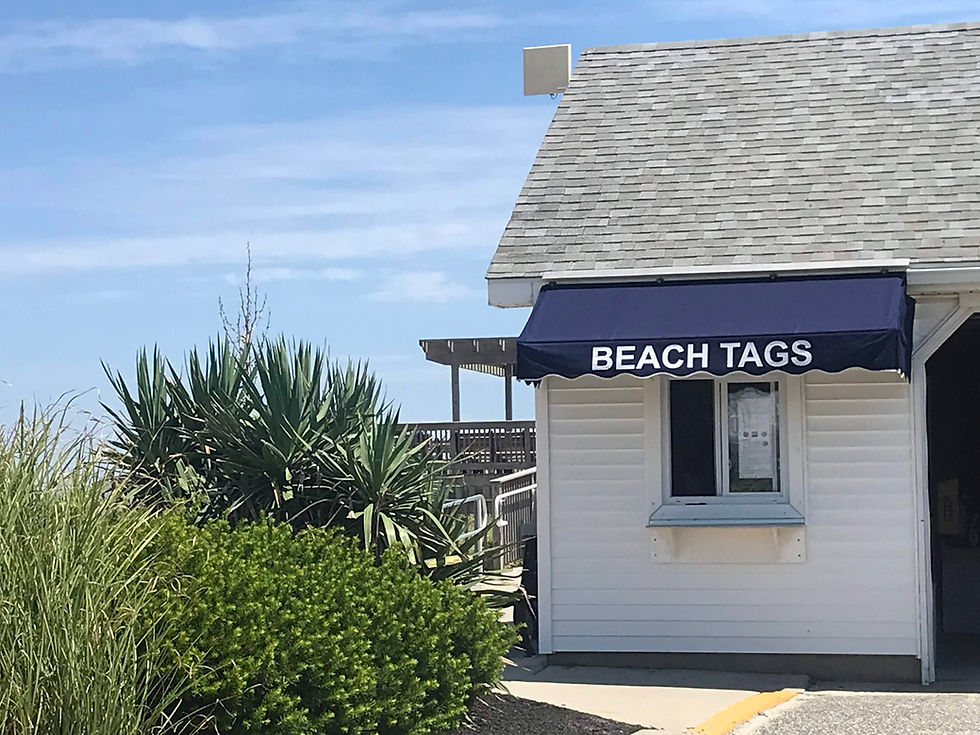A look at how the system operates for the Stone Harbor division
Ellis Kelsey | Seven Mile Satellite
Originally published 25 July 2019

Whether one is a renter, seasonal resident or ocean enthusiast, beach tags are likely part of the beach-going experience on Seven Mile Island. But ever wonder why Stone Harbor and Avalon require beach tags to use the public beach during day hours? Where do these funds go? What’s the deal with these things?
Beach tags serve primarily as a ticket for beach fun throughout the season. Their price depends on how many days the pass is for.
“There are three different tags: daily tag, which is $6; weekly tag, which is $12 and seasonal, which is 28,” Andrea Miller, a beach tag worker for Stone Harbor Beach Patrol said. “Before June 1, it’s 23 for a preseason pass.”

Avalon’s pricing is very similar.
Additionally, the beach tag operation offers a military discount, as Seven Mile Island maintains a considerable military presence.
“If you’re on active duty you get free seasonal for you, for your spouse and your dependents,” Miller said.
The beach tag system is one a lot of residents deal with but one few know much about. In fact, most South Jersey beaches require the possession of the local beach tag except for Wildwood.
“Wildwood’s the only free beach,” Miller said.
Even Avalon and Stone Harbor differ on beach tag operation with aspects such as whether taggers are at the top of the beach or not.

The workers expressed the relationship between the beach tagger checkers and beach-goers.
More often than not, a quick flash of one’s tag from a distance is enough to please the checkers. Often, beach-goers see the parading beach checkers as more of an annoyance than a convenience.
These tag checkers often encounter angry people when checking tags.
“It’s difficult for people out on the beach to understand how it works,” Miller said. “People say ‘Oh, the taggers are just walking,’ but they’re instructed to walk their blocks and walk back and check everybody.”
Dealing with the beach tag checkers is a small act of inconvenience considering their day-to-day: checkers remain on the hot sand for long stretches of time and must act courteous to all beach-goers.
The beach tag segment of the beach patrol is only one part of the Borough of Stone Harbor so it’s unclear at first exactly where the raised funds would go.
Jim Craft, a finance worker at the Borough of Stone Harbor, cleared it up. The money raised from beach tag sales goes directly into each borough’s local fund.
“The local fund supports beach operations, although [the beach tag sales] do not cover all of the beach,” Craft said.
They serve as an additional revenue stream for the local fund, an alternative to a heightened property tax.
This started in 1972 when the New Jersey legislature allowed municipalities to charge for beach tags. Since then, many beaches have decided to proceed with the idea. The method of funding on Seven Mile Island is one used up and down the Jersey coast, each beach with a slightly unique situation.
“Ocean City, for example, makes a lot of money on beach tags,” Craft said.
The sheer mass of homeowners, renters and seasonal tourists on larger beaches like Ocean City allow those boroughs to rake in a lot of revenue from beach tags over the summer.
So, beach tags do in fact fund beach patrol — lifeguards included. However, other beach operations for the island such as dune upkeep and policing aren’t completely covered by the local fund.
Still, the beach tag revenue takes a substantial chunk out of the tax burden in each borough, something the whole community seems to agree on. For beach bums, the burden of a $23 beach tag is likely a small price to pay for our pristinely-kept beaches.
Ellis Kelsey is a writer for the Seven Mile Satellite. Contact him at sevenmilesatellite@gmail.com.

Comentarios